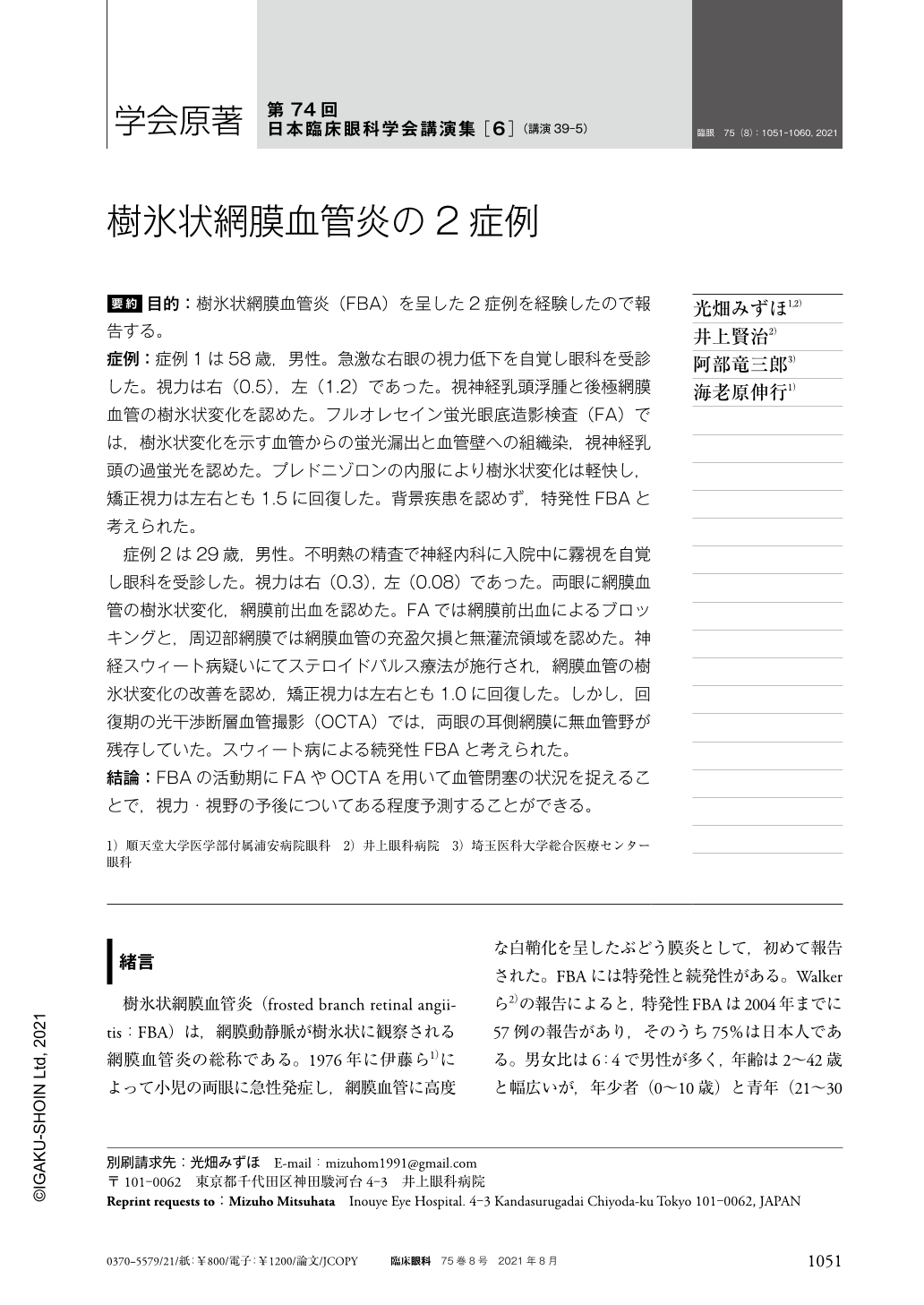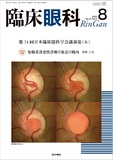Japanese
English
- 有料閲覧
- Abstract 文献概要
- 1ページ目 Look Inside
- 参考文献 Reference
要約 目的:樹氷状網膜血管炎(FBA)を呈した2症例を経験したので報告する。
症例:症例1は58歳,男性。急激な右眼の視力低下を自覚し眼科を受診した。視力は右(0.5),左(1.2)であった。視神経乳頭浮腫と後極網膜血管の樹氷状変化を認めた。フルオレセイン蛍光眼底造影検査(FA)では,樹氷状変化を示す血管からの蛍光漏出と血管壁への組織染,視神経乳頭の過蛍光を認めた。プレドニゾロンの内服により樹氷状変化は軽快し,矯正視力は左右とも1.5に回復した。背景疾患を認めず,特発性FBAと考えられた。
症例2は29歳,男性。不明熱の精査で神経内科に入院中に霧視を自覚し眼科を受診した。視力は右(0.3),左(0.08)であった。両眼に網膜血管の樹氷状変化,網膜前出血を認めた。FAでは網膜前出血によるブロッキングと,周辺部網膜では網膜血管の充盈欠損と無灌流領域を認めた。神経スウィート病疑いにてステロイドパルス療法が施行され,網膜血管の樹氷状変化の改善を認め,矯正視力は左右とも1.0に回復した。しかし,回復期の光干渉断層血管撮影(OCTA)では,両眼の耳側網膜に無血管野が残存していた。スウィート病による続発性FBAと考えられた。
結論:FBAの活動期にFAやOCTAを用いて血管閉塞の状況を捉えることで,視力・視野の予後についてある程度予測することができる。
Abstract Purpose:We report two cases of frosted branch retinal angiitis(FBA).
Case:Case 1:A 58-year-old man experoenced suffered from sudden visual disturbance. Visual acuity was 0.5 in the right eye and 1.2 in the left eye. Fundal examination revealed papilledema of the optic disc and frosted branch retinal angiitis in the posterior retina. FAG revealed fluorescein staining and leakages in the tracked vessels, and hyperfluorescence of the optic disc. When the patient was treated with oral prednisolone, the frosted branch angiitis diminished and his visual acuity recovered. No background disease was observed, and it was considered to be idiopathic FBA. Case 2:The patient was a 48-year-old man. He was admitted to the department of neurology for the examination of fever of unknown origin, where he consulted with an ophthalmologist for his blurred vision. Visual acuity was 0.3 in the right eye and 0.08 in left eye. Frosted branch retinal angiitis and preretinal hemorrhage were observed in both eyes. FAG revealed a blockage due to retinal hemorrhage, vascular occlusion and avascular area in the peripheral retina. Following, the patient was diagnosed with neuro-Sweet disease. After steroid pulse therapy, frosted branch angiitis was diminished, resulting in recovery of visual acuity OCTA examination showed that avascular area in peripheral retina of both eyes was remained. It was considered to be secondary FBA related to Sweet's disease.
Conclusion:FA and OCTA constitute a non-invasive and reliable examination method for capturing the status of vascular occlusion. Therefore, OCTA examination may be utilized for determination of suitable timing and dosage of systemic steroid administration to prevent widespread vascular occlusion of FBA.

Copyright © 2021, Igaku-Shoin Ltd. All rights reserved.


